Arjun Majumdar
Locate 3D: Real-World Object Localization via Self-Supervised Learning in 3D
Apr 19, 2025Abstract:We present LOCATE 3D, a model for localizing objects in 3D scenes from referring expressions like "the small coffee table between the sofa and the lamp." LOCATE 3D sets a new state-of-the-art on standard referential grounding benchmarks and showcases robust generalization capabilities. Notably, LOCATE 3D operates directly on sensor observation streams (posed RGB-D frames), enabling real-world deployment on robots and AR devices. Key to our approach is 3D-JEPA, a novel self-supervised learning (SSL) algorithm applicable to sensor point clouds. It takes as input a 3D pointcloud featurized using 2D foundation models (CLIP, DINO). Subsequently, masked prediction in latent space is employed as a pretext task to aid the self-supervised learning of contextualized pointcloud features. Once trained, the 3D-JEPA encoder is finetuned alongside a language-conditioned decoder to jointly predict 3D masks and bounding boxes. Additionally, we introduce LOCATE 3D DATASET, a new dataset for 3D referential grounding, spanning multiple capture setups with over 130K annotations. This enables a systematic study of generalization capabilities as well as a stronger model.
Subsurface Scattering for 3D Gaussian Splatting
Aug 22, 2024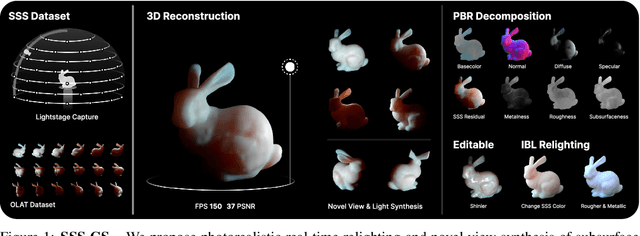

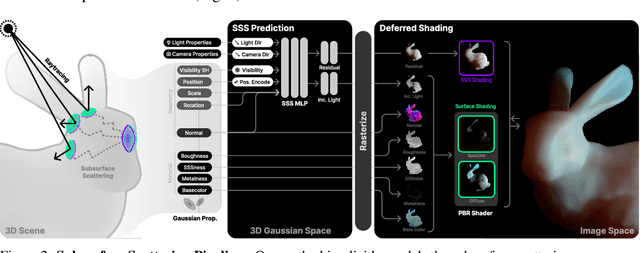

Abstract:3D reconstruction and relighting of objects made from scattering materials present a significant challenge due to the complex light transport beneath the surface. 3D Gaussian Splatting introduced high-quality novel view synthesis at real-time speeds. While 3D Gaussians efficiently approximate an object's surface, they fail to capture the volumetric properties of subsurface scattering. We propose a framework for optimizing an object's shape together with the radiance transfer field given multi-view OLAT (one light at a time) data. Our method decomposes the scene into an explicit surface represented as 3D Gaussians, with a spatially varying BRDF, and an implicit volumetric representation of the scattering component. A learned incident light field accounts for shadowing. We optimize all parameters jointly via ray-traced differentiable rendering. Our approach enables material editing, relighting and novel view synthesis at interactive rates. We show successful application on synthetic data and introduce a newly acquired multi-view multi-light dataset of objects in a light-stage setup. Compared to previous work we achieve comparable or better results at a fraction of optimization and rendering time while enabling detailed control over material attributes. Project page https://sss.jdihlmann.com/
Stretch with Stretch: Physical Therapy Exercise Games Led by a Mobile Manipulator
Dec 21, 2023



Abstract:Physical therapy (PT) is a key component of many rehabilitation regimens, such as treatments for Parkinson's disease (PD). However, there are shortages of physical therapists and adherence to self-guided PT is low. Robots have the potential to support physical therapists and increase adherence to self-guided PT, but prior robotic systems have been large and immobile, which can be a barrier to use in homes and clinics. We present Stretch with Stretch (SWS), a novel robotic system for leading stretching exercise games for older adults with PD. SWS consists of a compact and lightweight mobile manipulator (Hello Robot Stretch RE1) that visually and verbally guides users through PT exercises. The robot's soft end effector serves as a target that users repetitively reach towards and press with a hand, foot, or knee. For each exercise, target locations are customized for the individual via a visually estimated kinematic model, a haptically estimated range of motion, and the person's exercise performance. The system includes sound effects and verbal feedback from the robot to keep users engaged throughout a session and augment physical exercise with cognitive exercise. We conducted a user study for which people with PD (n=10) performed 6 exercises with the system. Participants perceived the SWS to be useful and easy to use. They also reported mild to moderate perceived exertion (RPE).
What do we learn from a large-scale study of pre-trained visual representations in sim and real environments?
Oct 03, 2023



Abstract:We present a large empirical investigation on the use of pre-trained visual representations (PVRs) for training downstream policies that execute real-world tasks. Our study spans five different PVRs, two different policy-learning paradigms (imitation and reinforcement learning), and three different robots for 5 distinct manipulation and indoor navigation tasks. From this effort, we can arrive at three insights: 1) the performance trends of PVRs in the simulation are generally indicative of their trends in the real world, 2) the use of PVRs enables a first-of-its-kind result with indoor ImageNav (zero-shot transfer to a held-out scene in the real world), and 3) the benefits from variations in PVRs, primarily data-augmentation and fine-tuning, also transfer to the real-world performance. See project website for additional details and visuals.
Behavioral Analysis of Vision-and-Language Navigation Agents
Jul 20, 2023



Abstract:To be successful, Vision-and-Language Navigation (VLN) agents must be able to ground instructions to actions based on their surroundings. In this work, we develop a methodology to study agent behavior on a skill-specific basis -- examining how well existing agents ground instructions about stopping, turning, and moving towards specified objects or rooms. Our approach is based on generating skill-specific interventions and measuring changes in agent predictions. We present a detailed case study analyzing the behavior of a recent agent and then compare multiple agents in terms of skill-specific competency scores. This analysis suggests that biases from training have lasting effects on agent behavior and that existing models are able to ground simple referring expressions. Our comparisons between models show that skill-specific scores correlate with improvements in overall VLN task performance.
* accepted to CVPR2023
Masked Trajectory Models for Prediction, Representation, and Control
May 04, 2023



Abstract:We introduce Masked Trajectory Models (MTM) as a generic abstraction for sequential decision making. MTM takes a trajectory, such as a state-action sequence, and aims to reconstruct the trajectory conditioned on random subsets of the same trajectory. By training with a highly randomized masking pattern, MTM learns versatile networks that can take on different roles or capabilities, by simply choosing appropriate masks at inference time. For example, the same MTM network can be used as a forward dynamics model, inverse dynamics model, or even an offline RL agent. Through extensive experiments in several continuous control tasks, we show that the same MTM network -- i.e. same weights -- can match or outperform specialized networks trained for the aforementioned capabilities. Additionally, we find that state representations learned by MTM can significantly accelerate the learning speed of traditional RL algorithms. Finally, in offline RL benchmarks, we find that MTM is competitive with specialized offline RL algorithms, despite MTM being a generic self-supervised learning method without any explicit RL components. Code is available at https://github.com/facebookresearch/mtm
Where are we in the search for an Artificial Visual Cortex for Embodied Intelligence?
Mar 31, 2023



Abstract:We present the largest and most comprehensive empirical study of pre-trained visual representations (PVRs) or visual 'foundation models' for Embodied AI. First, we curate CortexBench, consisting of 17 different tasks spanning locomotion, navigation, dexterous, and mobile manipulation. Next, we systematically evaluate existing PVRs and find that none are universally dominant. To study the effect of pre-training data scale and diversity, we combine over 4,000 hours of egocentric videos from 7 different sources (over 5.6M images) and ImageNet to train different-sized vision transformers using Masked Auto-Encoding (MAE) on slices of this data. Contrary to inferences from prior work, we find that scaling dataset size and diversity does not improve performance universally (but does so on average). Our largest model, named VC-1, outperforms all prior PVRs on average but does not universally dominate either. Finally, we show that task or domain-specific adaptation of VC-1 leads to substantial gains, with VC-1 (adapted) achieving competitive or superior performance than the best known results on all of the benchmarks in CortexBench. These models required over 10,000 GPU-hours to train and can be found on our website for the benefit of the research community.
OVRL-V2: A simple state-of-art baseline for ImageNav and ObjectNav
Mar 14, 2023Abstract:We present a single neural network architecture composed of task-agnostic components (ViTs, convolutions, and LSTMs) that achieves state-of-art results on both the ImageNav ("go to location in <this picture>") and ObjectNav ("find a chair") tasks without any task-specific modules like object detection, segmentation, mapping, or planning modules. Such general-purpose methods offer advantages of simplicity in design, positive scaling with available compute, and versatile applicability to multiple tasks. Our work builds upon the recent success of self-supervised learning (SSL) for pre-training vision transformers (ViT). However, while the training recipes for convolutional networks are mature and robust, the recipes for ViTs are contingent and brittle, and in the case of ViTs for visual navigation, yet to be fully discovered. Specifically, we find that vanilla ViTs do not outperform ResNets on visual navigation. We propose the use of a compression layer operating over ViT patch representations to preserve spatial information along with policy training improvements. These improvements allow us to demonstrate positive scaling laws for the first time in visual navigation tasks. Consequently, our model advances state-of-the-art performance on ImageNav from 54.2% to 82.0% success and performs competitively against concurrent state-of-art on ObjectNav with success rate of 64.0% vs. 65.0%. Overall, this work does not present a fundamentally new approach, but rather recommendations for training a general-purpose architecture that achieves state-of-art performance today and could serve as a strong baseline for future methods.
ZSON: Zero-Shot Object-Goal Navigation using Multimodal Goal Embeddings
Jun 24, 2022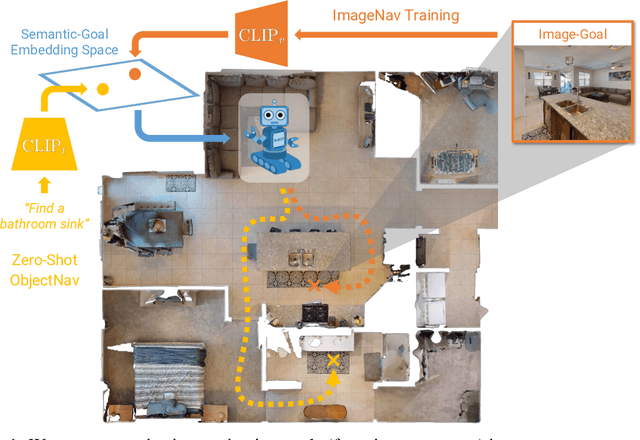

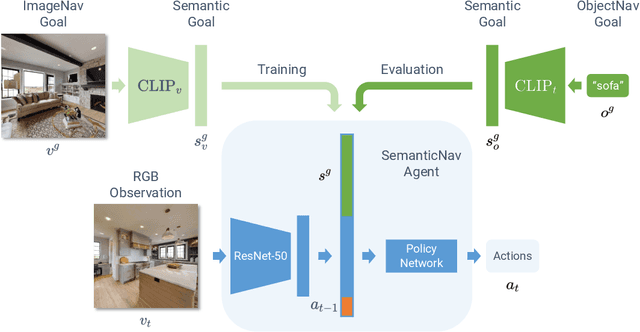

Abstract:We present a scalable approach for learning open-world object-goal navigation (ObjectNav) -- the task of asking a virtual robot (agent) to find any instance of an object in an unexplored environment (e.g., "find a sink"). Our approach is entirely zero-shot -- i.e., it does not require ObjectNav rewards or demonstrations of any kind. Instead, we train on the image-goal navigation (ImageNav) task, in which agents find the location where a picture (i.e., goal image) was captured. Specifically, we encode goal images into a multimodal, semantic embedding space to enable training semantic-goal navigation (SemanticNav) agents at scale in unannotated 3D environments (e.g., HM3D). After training, SemanticNav agents can be instructed to find objects described in free-form natural language (e.g., "sink", "bathroom sink", etc.) by projecting language goals into the same multimodal, semantic embedding space. As a result, our approach enables open-world ObjectNav. We extensively evaluate our agents on three ObjectNav datasets (Gibson, HM3D, and MP3D) and observe absolute improvements in success of 4.2% - 20.0% over existing zero-shot methods. For reference, these gains are similar or better than the 5% improvement in success between the Habitat 2020 and 2021 ObjectNav challenge winners. In an open-world setting, we discover that our agents can generalize to compound instructions with a room explicitly mentioned (e.g., "Find a kitchen sink") and when the target room can be inferred (e.g., "Find a sink and a stove").
Offline Visual Representation Learning for Embodied Navigation
Apr 27, 2022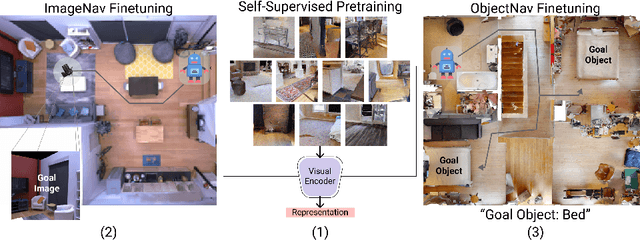
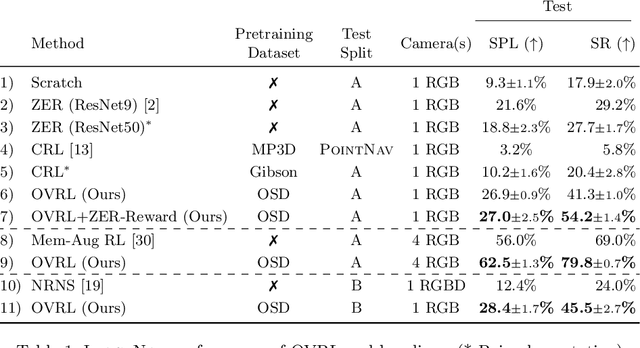

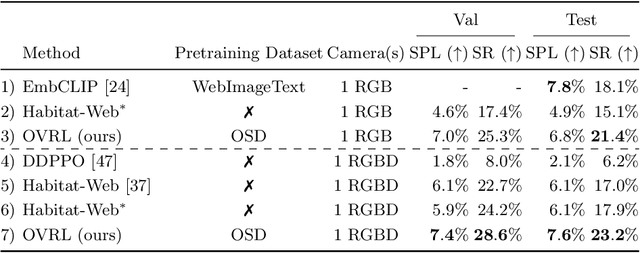
Abstract:How should we learn visual representations for embodied agents that must see and move? The status quo is tabula rasa in vivo, i.e. learning visual representations from scratch while also learning to move, potentially augmented with auxiliary tasks (e.g. predicting the action taken between two successive observations). In this paper, we show that an alternative 2-stage strategy is far more effective: (1) offline pretraining of visual representations with self-supervised learning (SSL) using large-scale pre-rendered images of indoor environments (Omnidata), and (2) online finetuning of visuomotor representations on specific tasks with image augmentations under long learning schedules. We call this method Offline Visual Representation Learning (OVRL). We conduct large-scale experiments - on 3 different 3D datasets (Gibson, HM3D, MP3D), 2 tasks (ImageNav, ObjectNav), and 2 policy learning algorithms (RL, IL) - and find that the OVRL representations lead to significant across-the-board improvements in state of art, on ImageNav from 29.2% to 54.2% (+25% absolute, 86% relative) and on ObjectNav from 18.1% to 23.2% (+5.1% absolute, 28% relative). Importantly, both results were achieved by the same visual encoder generalizing to datasets that were not seen during pretraining. While the benefits of pretraining sometimes diminish (or entirely disappear) with long finetuning schedules, we find that OVRL's performance gains continue to increase (not decrease) as the agent is trained for 2 billion frames of experience.
 Add to Chrome
Add to Chrome Add to Firefox
Add to Firefox Add to Edge
Add to Edge